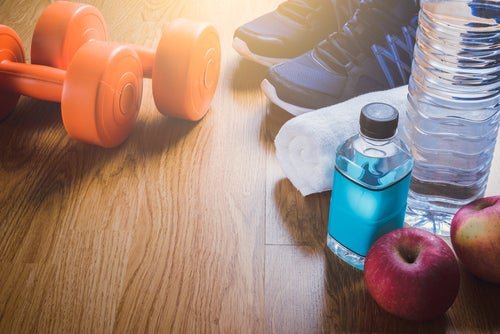5 Steps to Losing Weight This Winter

More people start weight-loss diets on Jan. 1 than on any other day of the year. The reason is primarily cultural, of course. Putting self-improvement resolutions into effect has become a traditional way to bring in the New Year.
Winter is also the best time for triathletes to pursue weight loss, but for a different reason. The goal of every triathlete is to perform to the best of their ability in races. Gaining fitness and shedding excess body fat are two effective ways to improve performance. However, the most effective dietary and training methods for gaining fitness are different from the most effective dietary and training methods for shedding excess body fat.
For this reason, it is best for triathletes to pursue these two objectives at different times. Obviously, fitness is the top priority during the summer racing season and the spring preparatory period. This leaves the winter as the ideal time to prioritize weight loss and to adopt the dietary and training methods that shed body fat most effectively.
Set aside four to eight weeks to function as a winter weight-loss focus phase. Use four weeks if you have just a little excess body fat to lose, six or eight if you’re well above your ideal racing weight. During this period, practice the following five dietary and training methods.
1. Count calories
When your primary goal is building fitness, it’s important that you eat enough to supply your body with enough energy to optimize your performance in training and your recovery between workouts. The best way to do this is to pay attention to your body’s hunger and satiety signals and allow these signals to regulate your food intake. In my experience as a sports nutritionist, athletes who instead limit themselves to prescribed calorie intakes tend to eat too little, sabotaging their own fitness development.
During a weight-loss focus phase, however, it does make sense to count calories. Specifically, you should aim for a moderate daily energy deficit of 300 to 500 calories. Research has shown that a moderate calorie shortfall yields significant weight loss in endurance athletes without sabotaging their training (provided you aren’t training at peak levels, as you shouldn’t be during the winter).
2. Eat more protein
High-protein diets are not conducive to endurance fitness building. A 2002 study found that runners who switched to a 30 percent protein diet experienced a nearly 10 percent decline in performance. Why? Research involving animals indicates that high-protein diets inhibit the creation of new mitochondria in the muscle cells in response to training, a crucial aspect of aerobic development.
However, when your primary goal is not gaining fitness but losing fat, a high-protein diet becomes a good thing. Studies show that elevated protein intake reduces appetite, making it easier to sustain a daily calorie deficit, and also increases resting metabolism, so more calories are burned outside of exercise. Aim to get 25 to 30 percent of your total calories from protein during your winter weight-loss focus phase. Here’s an example of what a 30 percent protein diet looks like:
Breakfast
Egg and vegetable scramble
Coffee
Snack
Fruit smoothie with protein powder
Lunch
Sausage and lentil soup
Whole grain bread
Snack
Celery sticks with peanut butter
Dinner
Chicken and broccoli stir fry
Quinoa
Snack
Greek yogurt with berries
3. Don’t cheat
Every high-performing triathlete whose diet I’ve studied eats a small number of unhealthy treats. Not only is it possible to attain maximum endurance fitness on an imperfect diet, but in a sense it’s even easier, because eating a treat here and there makes the diet as a whole more sustainable.
But within a weight-loss focus phase, it’s a good idea to eat as few treats as possible. Most athletes can muster the willpower to go treat-free for a few weeks, and doing so will give you that much more momentum in the direction of fat loss. Refined grains (e.g., most breads), sweets, processed meats, and foods containing added oils (including fried foods) should be avoided at this time.
4. Train less, but more intensely
Research has shown that endurance athletes of all experience, ability, and fitness levels improve the most when they do about 80 percent of their training at low intensity (i.e., below the ventilatory threshold, or about 77 percent of maximum heart rate) and the remaining 20 percent at moderate to high intensity. But the best way to train for weight loss is to do about half of your training at low intensity, half at high intensity, and little to none at moderate intensity.
Because high-intensity exercise is very stressful, the overall volume of training you do during a weight-loss focus phase should be significantly lower than it is within a race-focused training cycle. Here’s a basic example of a sensible weekly training schedule for this period.

5. Lift more weights
You probably noticed that the sample weekly training schedule given above includes as many strength workouts as it does swims, rides, or runs. There’s a reason for this. The true goal of a weight-loss focus phase is not really to lose weight, it’s to lose fat while preserving muscle. Research has shown that men and women who combine a calorie deficit with strength training lose more fat and less muscle than do people who eat less without lifting weights.
It’s a good idea to strength-train year-round, of course, but whereas two short gym sessions per week may be enough to keep you strong and injury-resistant at other times, three longer sessions will do more to help you get lean in a weight-loss focus phase. This shift in emphasis will also give you a reserve of strength—alongside a leaner body composition—to carry through the next racing season, during which strength training will necessarily be a lower priority.